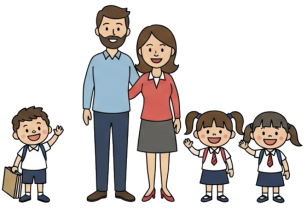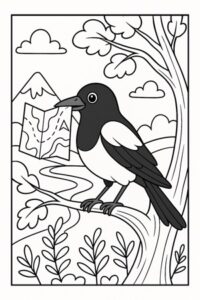
Question More, Action Knowledge.
Remember, at QMAK, we don’t just teach; we empower. We don’t just inform; we inspire. We don’t just question; we act. Become a Gold Member, and let’s unlock your child’s full potential, one question at a time.
Here you will find the resources that compliment the lessons taught during the month.
Songs are a great way to reinforce lessons in a fun, memorable way—by engaging musical and auditory learning styles, they help key ideas stick in children’s minds and support long-term retention well beyond the lesson.
(Verse 1)
We navigate this world, with maps in hand
Mental models, to help us understand
But a map is not the land, it’s just a guide
Reality’s complexities, it cannot hide
(Chorus)
Beyond the map, there’s a world to explore
Beyond the map, there’s always something more
Question the map, update and refine
The territory’s truth, we must seek and find
(Verse 2)
Reductions and snapshots, the map’s limitations
Structural differences, and interpretations
Dogmatism, ignoring feedback, oversimplification
Pitfalls to avoid, in our mental navigation
Treat reality as the ultimate update, consider the cartographer’s view
Map-territory confusion, a trap we must eschew
(Bridge)
Teach the children, this crucial distinction
Multiple perspectives, and continuous updating
In personal growth, and decision-making too
The map-territory concept, a tool to break through
(Chorus)
Beyond the map, there’s a world to explore
Beyond the map, there’s always something more
Question the map, update and refine
The territory’s truth, we must seek and find
(Verse 3)
Mental flexibility, effective communication
Continuous learning, and wise navigation
Humility and openness, the keys to growth
The map-territory distinction, a guiding oath
(Outro)
So let’s explore the territory, with maps in hand
But remember, they’re just tools, to help us understand
The landscape of reality, ever-changing and vast
Beyond the map, we must be willing to ask
Question more, and action knowledge too
The map is not the territory, a truth to construe
Having your child complete this coloring page right after reading the story helps transition the lesson from imaginative reading to creative expression, turning their thoughts into a vibrant work of art.
Color-In Picture

Movies are a great tool for engaging visual and auditory learners, and when paired with comprehension quizzes, they encourage active viewing—helping children process and retain key concepts rather than just being passively entertained.
Finding Nemo offers a delightful exploration of how “the map is not the territory” through Marlin’s journey across the ocean to rescue his son.
Through this overprotective clownfish’s adventures, students witness how his mental map of the ocean as an entirely dangerous place clashes with the complex reality he encounters.
The film demonstrates this concept as Marlin’s preconceptions are repeatedly challenged – from discovering that sharks can be friendly to learning that the seemingly ditzy Dory possesses crucial navigation skills.
As viewers follow Marlin and Dory’s quest across the ocean, they learn how our mental models (maps) of reality often fail to capture the true richness and nuance of the actual territory we’re traversing.
Through Marlin’s gradual recognition that his fear-based map of the world has limited both himself and Nemo, the film shows why understanding the difference between our mental maps and actual territory becomes crucial for navigating complex situations with wisdom rather than prejudice.
1. How does Marlin’s initial view of the ocean demonstrate the concept of an inaccurate “map”?
a) He sees it as a perfectly safe place
b) He views it as entirely dangerous, missing its complexity
c) He has no mental model of the ocean
d) His view perfectly matches reality
2. What does Marlin’s first encounter with the vegetarian sharks reveal about mental maps?
a) Mental models never need updating
b) His map was completely accurate
c) Reality can be more complex than our preconceptions
d) Sharks are always dangerous
3. How does Dory challenge Marlin’s “map” of what makes a capable navigator?
a) She confirms all his existing beliefs
b) She proves that careful planning is essential
c) She shows that different abilities can be valuable in unexpected ways
d) She demonstrates that memory is crucial
4. When Marlin meets the sea turtles, how does this experience update his “territory” understanding?
a) He learns that strangers can be trustworthy allies
b) He confirms that all strangers are dangerous
c) The turtles prove unhelpful
d) His original map was correct
5. What role does the Tank Gang play in showing the difference between map and territory?
a) They prove fish can’t survive outside their natural habitat
b) They show that seemingly confined spaces can contain unexpected wisdom
c) They demonstrate that plans always work
d) They confirm all of Marlin’s fears
6. How does Nemo’s experience at the dentist’s office challenge his father’s “map”?
a) It proves Marlin’s protectiveness was justified
b) It shows Nemo is completely helpless
c) It demonstrates Nemo’s capability for independence
d) It has no effect on Marlin’s views
7. What does Crush’s parenting style teach Marlin about his mental map of protection?
a) Confirms that strict control is best
b) Shows that there are different valid approaches to keeping children safe
c) Proves that no protection is needed
d) Demonstrates that all parents should be casual
8. How does the journey with Dory demonstrate the need to update our mental maps?
a) It shows maps never need changing
b) It proves first impressions are always right
c) It has no effect on Marlin’s worldview
d) It teaches Marlin to revise his assumptions based on experience
9. What does Bruce’s “Fish are friends, not food” philosophy reveal about mental maps?
a) That stereotypes can be oversimplified versions of reality
b) That all sharks are dangerous
c) That mental maps never change
d) That first impressions are always accurate
10. By the end of the film, what has Marlin learned about his mental map of the ocean?
a) It was perfect from the start
b) That reality is more nuanced than his fearful preconceptions
c) That the ocean is completely safe
d) That his initial fears were all justified
1. b
2. c
3. c
4. a
5. b
6. c
7. b
8. d
9. a
10. b
This beautifully illustrated book teaches children a simple yet powerful breathing technique to help them manage big feelings and find a sense of calm and balance.
1. What does the book call the special way of breathing?
a) Super breath
b) Magic breath
c) Fancy breath
d) Silly breath
2. What can the magic breath do according to the book?
a) Make you fly
b) Turn you invisible
c) Help you feel calm
d) Make you stronger
3. How does the book suggest you start your magic breath?
a) By running around
b) By closing your eyes
c) By talking loudly
d) By holding your breath
4. What does the book say you should focus on when breathing?
a) Your thoughts
b) Your feet
c) Your hands
d) The air moving in and out
5. What color does the book associate with calm, happy breaths?
a) Red
b) Blue
c) Green
d) Yellow
6. What does the book say you can do with worried or sad thoughts?
a) Keep them forever
b) Breathe them away
c) Ignore them
d) Give them to someone else
7. How does the book describe the feeling after using magic breath?
a) Tired and sleepy
b) Excited and jumpy
c) Calm and peaceful
d) Angry and frustrated
8. What does the book suggest you can imagine while breathing?
a) Only scary things
b) Nothing at all
c) Happy places or things
d) School work
9. When does the book say you can use your magic breath?
a) Only at bedtime
b) Only when you’re happy
c) Only at school
d) Anytime you need to feel calm
10. What is the main message of the book?
a) Breathing is only for exercise
b) Mindful breathing can help manage emotions
c) Magic is real if you believe
d) Calm feelings are not important
1. b) Magic breath
2. c) Help you feel calm
3. b) By closing your eyes
4. d) The air moving in and out
5. b) Blue
6. b) Breathe them away
7. c) Calm and peaceful
8. c) Happy places or things
9. d) Anytime you need to feel calm
10. b) Mindful breathing can help manage emotions
Transforming “The Awareness Expansion Game” into a catchy song gives children a powerful tool to manage overwhelming emotions through the universal language of music. The melody creates a memorable framework that helps children understand they are larger than any single feeling, teaching them to expand their perspective during emotional storms. This musical approach makes the abstract concept of mindfulness immediately accessible and enjoyable, providing children with a comforting tune they can recall and even hum to themselves when big feelings arise, ultimately building emotional resilience through the simple joy of song.
Verse 1:
When big emotions come to play
And seem to take my breath away
I pause and take a little look
At all the pages in life’s book
Pre-Chorus:
There’s more to see, more to hear
More than just the feelings near
Chorus:
I’m bigger than my feelings, yes it’s true
There’s so much more to me and you
Expand awareness, let it grow
There’s a whole world we can know
Verse 2:
Listen to the birds outside
Feel my feet, they’re my guide
See the colors all around
My breath, a gentle rising sound
(Pre-Chorus)
(Chorus)
Bridge:
Sadness, anger, joy or fear
They’re just visitors here
I can hold them gently, and still see
All the other parts of me
(Chorus)
Outro:
Open up and you will find
There’s room for all inside your mind
Emotions come and emotions go
But awareness helps us grow

Remember, at QMAK, we don’t just teach; we empower. We don’t just inform; we inspire. We don’t just question; we act. Become a Gold Member, and let’s unlock your child’s full potential, one question at a time.